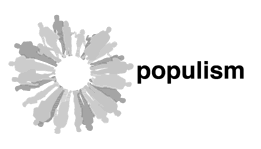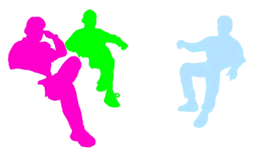Gardar Eide Einarsson & Matias Faldbakken
In relation to Oslo’s plan to change Bjørkvika – an otherwise run down harbour area in the city – into a fashionable neighbourhood, including a fancy opera, Gardar Eide Einarsson and Matias Faldbakken were invited to focus on the area in an exhibition arranged by the Museum for Contemporary Art in Oslo in 2002. Until then, Bjørkvika was (among other things) known for being a meeting place for the city’s junkies. Therefore Einarsson and Faldbakken chose to comment on the announced gentrification with a site-specific sculpture under the motorway bridge in Bjørkvika, where the junkies would normally find shelter against the rain. Whoomp – there it is was a large, circular sculpture with a white cover, reminiscent of a piece of lounge furniture in a trendy club, made for sitting on. During the exhibition period, the artists made sure that a hole in the middle of the sculpture was always filled with Litago – a chocolate milk said to be a favourite of both children and junkies. In this way the work became a meeting place for both new and old users of Bjørkvika.
Einarsson and Faldbakken’s collaboration began in 1998, when they founded the independent exhibition space, Bergen Museum for Samtidskunst, and arranged a series of exhibitions, film screenings, concerts and lectures. In the beginning the museum was in a sausage stand, but later it turned into a more immaterial construction, which was responsible for a number of publications and fictitous art projects. The two artists are also editors of the Norwegian art/theory magazine UKS Forum. Einarsson and Faldbakken’s collaborative projects are all interrelated and they often deal with the hidden structures of art and capital. Whoomp – there it is can therefore also be seen as a problematisation of the use of art in relation to the planned gentrification.
One of Einarsson and Faldbakken’s latest projects, Rank Xerox, is about the relationship between art and the art institution. The project can in itself be seen as a concrete illustration of art’s production of meaning. The minimal exhibition consisted of four photocopiers, piles of paper and specially designed tables and benches. Moreover, the artists had invited various artists and writers to submit texts and drawings, all of which were made on A4-sheets of paper. The audience could select and copy the originals that they found interesting, and collect a unique and personal catalogue of the exhibition. In this way each visitor could define the content of the exhibition. This simple self-service situation concretises the precise relationship between the spectator, work and institution – and at the same time presents a notion of art that is so reduced that it excludes talking about two of the archetypes of art history, namely the copy and the original.
By Pernille Albrethsen, translated by Eva May
"01 RANK XEROX" (2004) (four xerox copiers, pallet of paper, ten tables/benches, two electric staplers, various submitted texts and images for copying ?) (Installation view from Bergen Kunsthall, Bergen, NO)
Photo: Gardar Eide Einarsson
|









